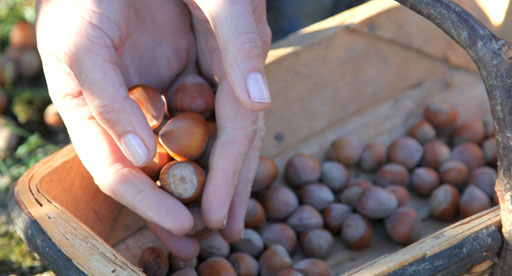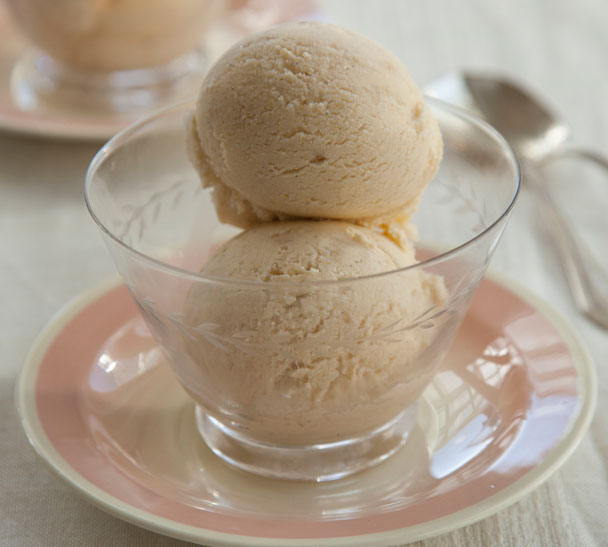
There’s a magic about April, a breathlessness that holds sway in the stillest of clear blue-skied days, the air so crisp you could snap it with your fingers. Each day you can watch the landscape morphing every hue of wildfire in nature’s last hurrah.
I feel like a squirrel at this time of year, heading out in the crisp of the morning with the sounds of rustling leaves and the honking calls of gathering migratory geese out on the lake reminding me that I must hurry to gather the last of the apples and pears, store the pumpkins and pick nuts and seeds and any frost-tender vegetables. Soon, suddenly, it will be over, the birds will be gone, the leaves will be gone and the first icy blasts of winter will render the landscape mute.
Inside, you can almost guarantee that the fire will be roaring and the kitchen busy, with a line-up of harvests awaiting their turn – apples for stewing, the last summer veg for soups and sauces, and pears for chutneys and breakfast preserves. Almonds, hazelnuts and the first walnuts are collected and spread on the floor by the fire to dry, before being hung in sacks away from the relentless appetites of winter rodents.
Back in Auckland, where it’s so much milder, there are more harvests on offer right now – persimmons, passionfruit, feijoas and the first citrus are all ready to pick – but there’s little of the magical colour display that seizes the landscape in Wanaka (you can tell my heart is in the south!).
Out in the garden, apart from boring tasks like cutting back and tidying, this happens to be the best time to plant fruit trees. Even if you have a tiny back yard it’s so pleasurable to have a tree that offers something useful and good to pick. The first thing you need to consider is space – when you buy a tree you often don’t have any idea of how big it will grow or what its mature form will be. Fruit and nut trees all look much of a muchness in their black poly bags at the nursery, but they certainly don’t all grow the same. Check the label or ask a knowledgeable garden centre attendant for advice.
If you have limited space or if you’re growing in a container choose something that won’t grow too big – like a quince tree, one of the smaller crab apples, any of the dwarf fruit varieties, or even an olive, which can be pruned. There’s no point planting a walnut tree or even a chestnut tree unless you have room for it.
Try to find out which varieties are best suited to your location, as heritage tree types are often resistant to bugs and diseases. Multi-grafted trees, which have two or three varieties on the same plant, are another clever idea, especially for small spaces, offering you the pleasure of different fruit from just the one tree.
Right now, while the air is cooler but the soil is still warm, is the perfect time to plant fruit trees and nut trees, as it gives them time over the winter to establish their root systems in preparation for the following growing season. The rule of thumb is to remove all the newly formed fruit during the first season so the tree can put its energy into the root system.
In general you need to wait a few years before your fruit and nut trees come into full production but once they do you will find yourself hard-pressed to keep up. But since when has having too much fruit been a problem? It’s wonderful to be able to offer fresh fruit to friends and family or put a ’help yourself’ bucket on the street for passersby to enjoy – such a good way to build a neighbourly spirit.
To get to this wonderful point of having fruit to give away, you first need to get your tree or trees planted. Having ascertained the type of tree you want and chosen a strong healthy specimen, you now need to put your best efforts into planting it so it will grow happily and healthily.
Fruit trees (or any plants for that matter) won’t grow where the soil contains too little air and insufficient nutrients. Heavy clay is a challenge and will need lightening and very light, sandy soil will need more organic matter and weight to hold the water your tree will need.
While you’re preparing your soil, soak your tree in its bag or container in diluted Tui Organic Seaweed Plant Tonic, ensuring that all the air bubbles are gone before planting. (I fill the wheelbarrow with water and Tui Organic Seaweed Plant Tonic and then roll the tree around in this until it is fully soaked, then use the leftover Tui Organic Seaweed Plant Tonic mixture to water the plant in once it’s in the ground.)
Whether you’re starting with an existing garden bed or bare soil, dig over the soil in an area of about twice the depth and width of the rootball of your tree (gently tease out the rootball so you get a sense of how wide it is). Loosen the soil around the base and sides of the hole if it’s very dense. Dig in organic matter like sheep pellets and compost. If you’re working with acidic soil (the presence of sorrel and a sour smell to the earth are good indicators) dig in some lime too. Then add a layer of Tui Garden Mix.
Pile some of the fertilized soil mix back into the hole to the same depth as the tree sits in its plastic wrapper or pot – I just drop the empty wrapper or pot back into the hole so I can ensure the right depth. It’s really important you don’t plant too deep or the tree will die. It needs to be planted at the same depth that it was growing at the nursery.
Place the tree in the planting hole and if necessary insert a stake. Where I live I always need to stake my trees as it’s windy so the tree roots get loosened and air gets in before they have established – your tree will not be at all happy about this. Refill the planting hole carefully, placing soil between and around all the roots to eliminate any air pockets. Press the soil firmly all around the trunk, but don’t compact it into a hard mass. Add a layer of Tui Mulch & Feed about 5cm deep within the drip-line to suppress weeds and help conserve moisture, but don’t let it sit hard up against the trunk as it can cause rot. Give the tree a good water with Tui Organic Seaweed Plant Tonic and be sure to give it a good soak at least once a week if there is no rain. If you have problems with rabbits you’ll want to staple a plastic sheath around the trunk to prevent it from being ring-barked (that’s a lesson hard learnt down here in rabbit country).
If you are planting your tree in a container rather than the open ground you need to employ a slightly different strategy. Partly fill your pot with Tui Pot Power then tap the pot on the ground to settle the mix. Place your tree in the pot and fill the pot with Tui Pot Power, ensuring the tree is no deeper than it was in the container or bag. Add a layer of Tui Mulch & Feed about 5cm deep, being careful not to leave it touching the trunk. Water your tree well before and after planting with Tui Organic Seaweed Plant Tonic – this will help avoid transplant shock.
Anyone with a feijoa tree will be flooded with fruit at the moment, so here is a super simple recipe for Cheat’s Feijoa Ice Cream that you can make with any kind of stone fruit or pip fruit as well.
Annabel's Cheat’s Feijoa Ice Cream
This super-simple dessert is made with good quality store-bought ice cream and fresh, ripe feijoas.
Prep time: 10 mins + freezing
Cook time: 5 mins
Serves: 6
Ingredients
- 6 large feijoas, peeled and sliced
- ½ cup sugar
- 1 litre store-bought vanilla ice cream
Method
- Purée feijoas and sugar in a food processor.
- Place purée in a bowl and microwave for 5 minutes, or place in a pot and bring to a simmer.
- Cool then chill for at least 1 hour.
- Soften ice cream for 15 minutes or microwave for a minute.
- Mix with a wooden spoon or blitz in food processor until creamy (do not let it melt).
- Swirl chilled feijoa purée through ice cream, return to container and refreeze for at least 4 hours before serving.
Read more of Annabel's guest blogs here
Post a comment
Annabel Langbein's April Garden Comments
Hi would this work by making the ice cream from your free range cookbook?
Sarah
Feijoas are the one fruit that I know of that do not require sugar when cooked.
Lorna Baxter
I have a citrus tree in a container that needs to be planted out in the garden. Is this a good time to do this?
Tamsin
Hi Tamsin, thank you for your question. Yes, now is a good time as there is some moisture in the ground. Give the tree a couple of doses of Seasol plant tonic before shifting as this will help reduce transplant shock. Gently tease out the roots once removed from the pot to encourage new root growth. Thanks, Jenna - Tui Team
jenna
Hi Sarah, yes you could just make the Ice Cream Base in The Free Range Cook (page 227) and fold in the feijoa puree instead of the Pistachio Flavouring. Great idea – it sounds delicious! Thanks, Jenna - Tui Team
jenna
I have 1 lime, 1 orange and 1 lemon in individual largish clay pots. Ive got mulch on the soil, I add citrus fertiliser a couple of times per year and keep up with the watering (most of the time). I notice with the lemon tree especially that some of the green leaves have turned quite yellow (smallish tree maybe 10 or so leaves). Otherwise the tree and dark green new lemons look fine. Any suggestions please? Or is this normal?
Mickey
Hi Mickey, give the citrus regular waterings with Seasol seaweed based plant tonic. Yellow leaves is usually a sign of lack of magnesium, being in pots nutrients leach out a lot quicker than in the soil so regular feeding is important and liquid feeding over summer every couple of weeks will help plants get through the hot summer months. Don’t feed the tree now as you don’t want to push soft new growth that doesn’t have time to harden off before winter, you can mix Epsom salts up in a watering can and apply around the tree. Seasol is okay to use through the winter months. Thanks, Jenna - Tui Team
jenna
Is it possible to freeze the feijoa puree, as my daughter would like the ice cream for Christmas, when she is home from Aussie. Thanks
Leigh Fordyce
This is a great recipe, thoroughly enjoyed by the whole family.
Margaret
Hi Leigh, yes it is possible to freeze the feijoa puree. Enjoy! Thanks, Jenna - Tui Team
jenna